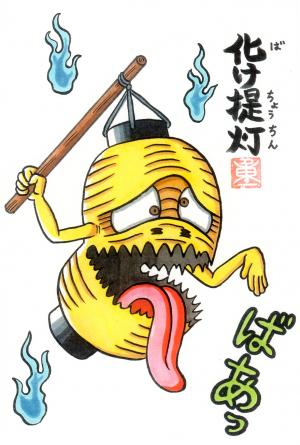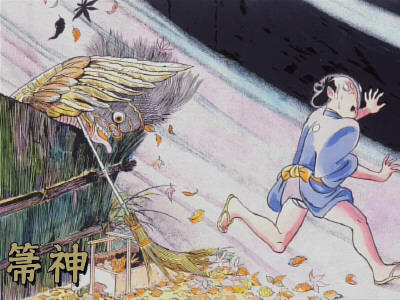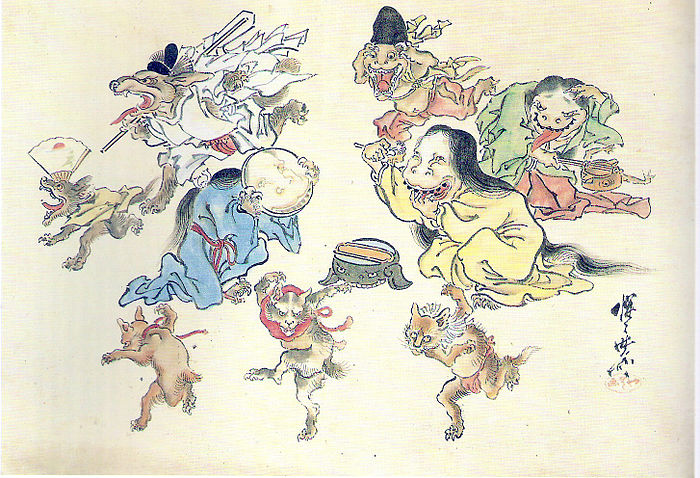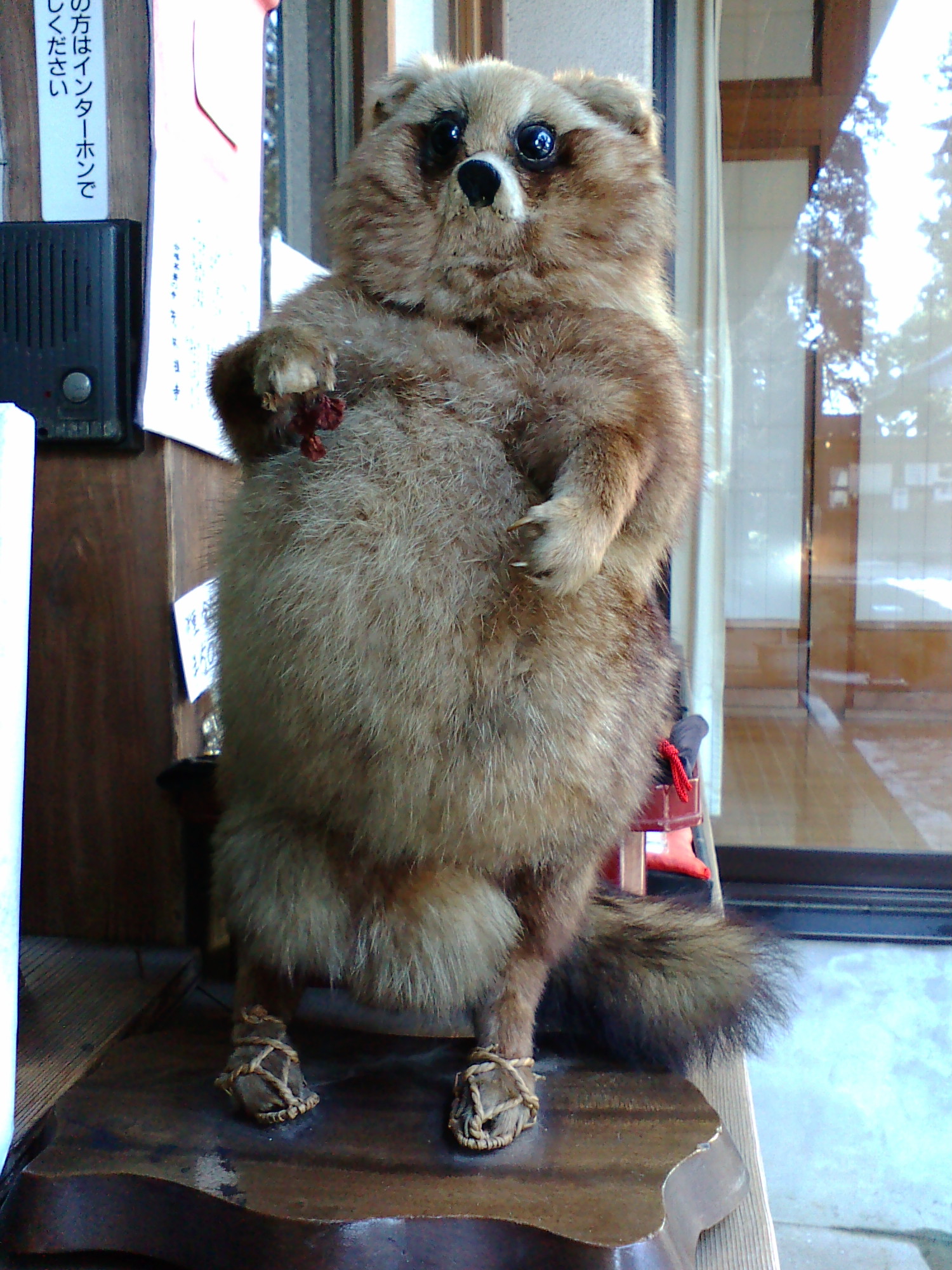
日本の古来の文化を紐解いていくと、日本にハロウィンが定着したのは当然だ。
When you take a look into Japan’s traditional culture, it’s completely natural that Halloween has taken hold in Japan.
Since it’s almost Halloween, I thought I’d share some more 妖怪 (Yōkai), or Japanese monsters which are commonly known and used in various media. Some Yōkai are demons, others possessed people, or even objects that were used for many years (especially 100+ years) which become inhabited by a spirit. I’ve personally been freaked out by old items my entire life, and it’s good to know I’m not the only weirdo. (Okay, that was a superstition hundreds of years ago…).
If you haven’t read the post from last year, check it out!
提灯お化け (Chouchin-obake) This translates to “paper lantern monster”. Sometimes when paper lanterns (提灯) get to an old age, and thus susceptible to becoming possessed by a spirit, they can sprout an eye or two at the top, with the bottom splitting open to create room for their long tongue. This is a Yōkai who usually just likes to frighten people by being creepy, not really wanting to hurt anyone. The image started popping up sometime after the Edo period, where it was used in picture books and playing card games, and during the Meiji and Taisho periods started being used in haunted houses and children’s toys.
This translates to “paper lantern monster”. Sometimes when paper lanterns (提灯) get to an old age, and thus susceptible to becoming possessed by a spirit, they can sprout an eye or two at the top, with the bottom splitting open to create room for their long tongue. This is a Yōkai who usually just likes to frighten people by being creepy, not really wanting to hurt anyone. The image started popping up sometime after the Edo period, where it was used in picture books and playing card games, and during the Meiji and Taisho periods started being used in haunted houses and children’s toys.
箒神 (Hahaki-gami)
 This translates to “broom god”, though the word for broom is usually pronounced ほうき (houki), and not ははき (hahaki). Brooms were used a in ritual ceremonies to sweep away bad energy and evil spirits, and following the theme, after time brooms become vulnerable to spirits residing in them. They then become Hahaki-gami, taking on a scary appearance with wide-open eyes. The Hahaki-gami are actually thought to be more helpful in the fact that they will get rid of people who might over stay their welcome, or they are used as a charm for safe childbirth, getting rid of evil spirits and ensuring an easy delivery.
This translates to “broom god”, though the word for broom is usually pronounced ほうき (houki), and not ははき (hahaki). Brooms were used a in ritual ceremonies to sweep away bad energy and evil spirits, and following the theme, after time brooms become vulnerable to spirits residing in them. They then become Hahaki-gami, taking on a scary appearance with wide-open eyes. The Hahaki-gami are actually thought to be more helpful in the fact that they will get rid of people who might over stay their welcome, or they are used as a charm for safe childbirth, getting rid of evil spirits and ensuring an easy delivery.
百鬼夜行 (Hyakki-yagyō)
 Translating as “Night Parade of One Hundred Demons”, Hyakki-yagyō is a night not just for one specific creature, but a night parade of one hundred demons including ghosts, spirits, and other supernatural creatures, where they leave their homes and parade around the streets. People must stay inside and not look out windows on nights like these as they could be killed or taken away by the supernatural beings.
Translating as “Night Parade of One Hundred Demons”, Hyakki-yagyō is a night not just for one specific creature, but a night parade of one hundred demons including ghosts, spirits, and other supernatural creatures, where they leave their homes and parade around the streets. People must stay inside and not look out windows on nights like these as they could be killed or taken away by the supernatural beings.
化け狸 (Bake-tanuki) Last and certainly not least, is another Yōkai who tends to not be harmful to others, the extremely popular Tanuki– it’s definitely one of the most popular forms of Yōkai. The Tanuki is an actual animal native to Japan which resembles a raccoon– outside of Japan they are called the “Japanese racoon-dog”. In folklore, they are mischievous creatures who change their shape to whatever they like, (usually human form), and enjoy playing tricks on humans, though they are easily fooled and absent minded.
Last and certainly not least, is another Yōkai who tends to not be harmful to others, the extremely popular Tanuki– it’s definitely one of the most popular forms of Yōkai. The Tanuki is an actual animal native to Japan which resembles a raccoon– outside of Japan they are called the “Japanese racoon-dog”. In folklore, they are mischievous creatures who change their shape to whatever they like, (usually human form), and enjoy playing tricks on humans, though they are easily fooled and absent minded.
A famous feature of the Tanuki happens to be their disproportionally large testicles (due to the fact the actual animal has quite large ones) which have been exaggerated to the point in folklore, that they’ve been shown flung over their backs like travelers’ packs, or using them as drums. ♪Do your 玉 hang low, do they wobble do they flow♪
As a note, the word 化け狸 (bake-tanuki) is used to distinguish the Yokai form from the actual animal (狸). The character 狸, is pronounced “lí” in modern Mandarin, and was originally a name for medium sized animals resembling cats. However, when the character was adopted in Japan, it couldn’t be suitably applied to any animals, so Japanese starting using 狸 for Tanuki, (and stray cats, wild boars, badgers, weasels, and Japanese flying squirrels).
The Tanuki used to be known as a being that governs all things in nature, but after the arrival of Buddhism, animals who weren’t directly servants of the gods (like a fox) lost their divinity. All that remained was the image of possessing special powers, and so Tanuki were then seen as evil. Some also think the image of the Tanuki overlapped with the 狸 of China (leopard cat), however since the racoon-dogs in Japan don’t have a scary image like leopard cats do, the image associated took the form of a more humorous kind of monster.
In Japanese slang, タヌキ顔 (Tanuki-gao), translating to “Tanuki face”, refers to a face that looks like an animal, or a facial expression of feigned ignorance. On the other hand, キツネ顔 (“fox face”) is used for people with narrow faces, close-set eyes, thin eyebrows, and high cheekbones. Foxes in folklore also have the ability to shape-shift, however the Tanuki is considered superior, hence the expression “The fox has seven disguises, the tanuki has eight”. (狐七化け、狸八化け).
If you like Japanese monster folklore, a site you can check out with great artwork and small bios for countless yōkai can be found at yokai.com
